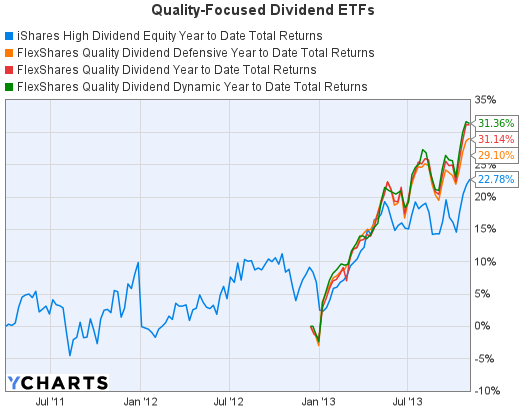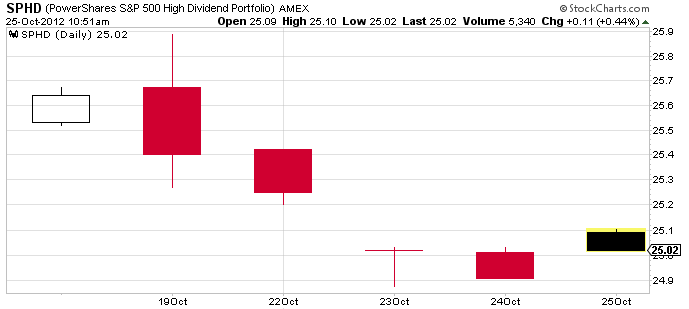ETFs Combining Low Volatility and High Dividend Yields
Post on: 14 Июль, 2015 No Comment

ETFs Combining Low Volatility and High Dividend Yields
Low-volatility investing strategies have proven to be effective in recent years, producing superior returns relative to broad market benchmark. In fact, research confirms that investing in stocks with less volatile return patterns relative to those of the broad market benchmarks produces higher risk-adjusted returns over the long term than investing in stocks with high-volatility returns or the market as a whole. As low-volatility is generally associated with low risk, this finding contradicts the main principle of the Capital Asset Pricing Model which says that higher assumed risk should yield higher expected rates of return. The reason why low-volatility stocks historically have outperformed their high-volatility peers and the market is partly due to their ability to limit drawdowns while leaving room for participation in market upturns. This suggests that low-volatility investing is most appropriate during market corrections, but it may not be best suited for long bull markets, during which low-volatility investments tend to underperform high-volatility investments or broad market indices.
There is a number of investment vehicles constructed to provide investors with access to factor-driven, low-volatility investing strategies. In fact, several exchange-traded funds (ETFs) provide a double dose of the downside protection with respectable income through a combination of low-volatility and high-yielding dividend stocks. Hence, these ETFs merge the two most popular investment strategies from recent years into a single investment product. While there are a number of low-volatility ETFs that make distributions, a few are explicitly focused on delivering both low-volatility and ample dividend yield. Notable examples include PowerShares S&P 500 High Dividend Portfolio (NYSE: SPHD) and Global X SuperDividend U.S. ETF (NYSE: DIV). For investors who want to pursue these strategies in growth markets abroad, there is also an ETF focused on emerging-market equities, the EGShares Low Volatility Emerging Market Dividend ETF (NYSE: HILO).
The PowerShares S&P 500 High Dividend Portfolio ETF seeks to approximate the price performance (before fees and expenses) and yield of the S&P 500 Low Volatility High Dividend Index. The index comprises of 50 least-volatile and high-yielding dividend stocks of the S&P 500. The Index and the corresponding ETF are mostly concentrated in the large-cap value segment, with utilities assuming a 24.29% weight, followed by financials (18.87% weight) and consumer staples stocks (15.67% weight). The fund, which makes monthly distributions and charges a 0.30% management fee, has a 30-day SEC yield of 3.77% and a distribution yield of 3.84%. The funds top holdings include the traditionally defensive plays such as tobacco firms Lorillard (NYSE: LO), Altria Group (NYSE: MO), and Reynolds American (NYSE: RAI), as well as utilities Exelon (NYSE: EXC) and Pepco Holdings (NYSE: POM). The ETF has realized a 10.42% gain since its inception on October 18, 2012, which has trailed the S&P 500 Indexs gain of 17.84% over the same period. However, back-tested, the underlying index outperformed the S&P 500 in four out of the past five years.
The Global X SuperDividend U.S. ETF tracks the performance of the INDXX SuperDividend U.S. Low Volatility Index, comprising of 50 equities, ranked among some of the highest dividend-yielding U.S. securities that are equally weighted. The fund applies a low-volatility filter to reduce the volatility of the portfolio. Sector caps of 25% are imposed to ensure that the portfolio is not overly exposed to particular sectors. As a result, the fund has a 24.1% weight in utilities, 16.1% weight in energy, and 13.6% weight in real estate. The fund makes monthly distributions and carries a 30-day SEC yield of 6.69% and a distribution yield of 6.38%. It charges a management fee of 0.45% (which equals its total expense ratio). Aside from holding Lockheed Martin (NYSE: LMT), United Online (Nasdaq: UNTD), and World Wrestling Entertainment (NYSE: WWE) in its top 10 positions, this ETF also includes in its top assets the tobacco majors Lorillard and Reynolds American. The fund realized a loss of 0.89% over the six months through September 30, 2013, which trailed the S&P 500s total return of 8.31% over the same period. This ETFs inception date was March 11, 2013.
For investors seeking exposure to growth-driven emerging markets, the EGShares Low Volatility Emerging Market Dividend ETF offers that access through low-volatility income strategies. This ETF seeks returns (before fees and expenses) that correspond to the price and yield performance of the Indxx Low Volatility Emerging Markets Dividend Index. The Index is dividend yield-weighted and is designed to provide a higher dividend yield with a lower relative volatility of returns than the MSCI Emerging Market Index. The fund consists of 30 holdings, with financials, industrials, and telecommunications accounting for 21.0%, 20.83%, and 14.99%, respectively, of the overall fund value. Securities from South Africa, Turkey, and Thailand account for over half the overall fund value. The ETF has a total annual expense ratio of 0.85%. It makes quarterly distributions and has a 12-month yield of 4.87%. Its top three positions include a South African holding group Lewis Group (JNB: LEW), operating as a household furniture and appliance retailer and an insurance company, Aygaz (IST: AYGAZ), a Turkey-based oil and gas marketing and distribution company, and Vodacom Group (JNB: VOD), a South African telecommunication and data communication services and products firm. Initiated on August 4, 2011, this ETF produced a one-year total return of negative 0.61%, while the MSCI Emerging Market Index made a gain of 0.98% over the same period.
Aside from these ETFs, there are several low-volatility ETFs that do not explicitly focus on high-yeild dividend stocks, but still produce respectable dividend (distribution) yields. Some of the more popular and liquid ones include:

PowerShares S&P 500 Low Volatility ETF (NYSE: SPLV) [12-month yield: 2.84%]
PowerShares S&P International Developed Low Volatility ETF (NYSE: IDLV) [12-month yield: 2.69%]
iShares MSCI Emerging Markets Minimum Volatility ETF (NYSE: EEMV) [12-month yield: 1.73%]
All featured ETFs are provided as a basis for further research in regard to low-volatility, dividend yield-focused investment strategies that seek to achieve a combination of drawdown minimization and income generation. For income-focused dividend investors, their evaluation should be made in the context of the markets expected direction and trends in interest rates/yields of competing investment products. Still, while low-volatility and dividend ETFs may have produced superior historical results, it must be noted that past performances are not an indication of any future returns.














